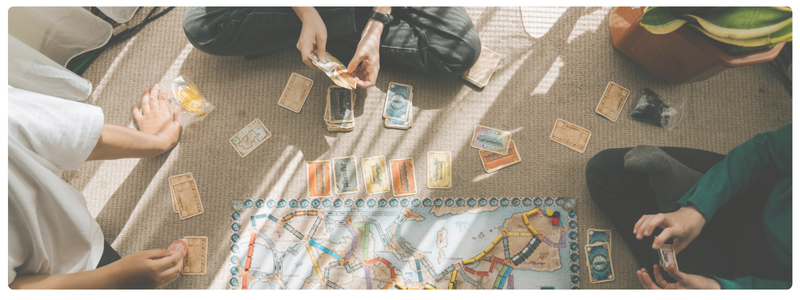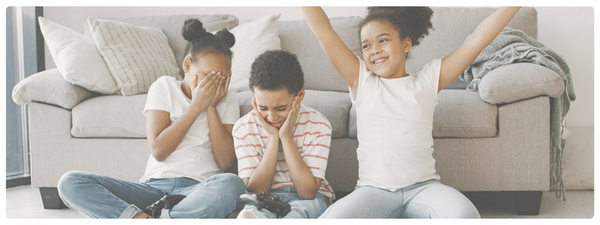As digital parents, we’re often caught between conflicting headlines in our everyday realities, raising digital natives.
One moment, screens are framed as harmful; the next, they’re hailed as educational powerhouses. Meanwhile, we just want to make dinner in peace and maybe feel a little less guilty about putting on an episode of their favorite cartoon.
When we cut through all the noise, where do we land? Should we, as parents, limit screen time for kids?
Cue the standard (but accurate) short answer: It depends.
The longer answer? It’s not about how much to limit screen time — it’s about how. It's time to reframe this debate.
With the help of research-backed insights and everyday strategies, let’s walk through some of the pros, cons, and practical takeaways for setting thoughtful screen time boundaries (without shame, nightly battles, or unrealistic goals).
A New Way to Think About Screen Time Limits
Parents often feel guilty or uncertain about screen time. Without clear information, it’s easy to worry we’re doing something wrong — especially when we use screens as a tool to occupy our kids while we work, clean, or recharge (we all do it). But let’s be clear: that’s not a sign of failure. That’s just part of parenting in the 21st century.
Hear me out:
- Sometimes you just need to make dinner.
- Sometimes you have to take a phone call outside of office hours.
- Sometimes, you just need five minutes of someone not calling your name (I know that’s not just me!).
These are all completely normal reasons to need a quick break — and screens can be a tool for that. Before screens, parents used other tools for the same purpose.
My father told me many stories of his parents giving him the old, “Go outside and don’t come home until it’s dark” method. When I was a kid, it was, “Go to your room and find something to do.”
Are these options better than screens? Perhaps in some ways. When my father was outside, he was getting fresh air, playing with neighborhood friends, and being creative. In my room, I was reading a book or doing a craft. But wait — all of those things can also happen for our kids while using screens.
Maybe these generationally different techniques aren’t so functionally different, after all.

Let’s move away from fear and judgment and focus on balance, context, and intention. We’re not here to restrict or eliminate screens. We’re here to guide, support, and build skills for healthy digital lives.
Screens are not a glaring threat to our kids’ wellbeing, and they’re not just a treat — they’re a tool for today’s digital parents.
The Case for Screen Time Limits: Teaching Self-Regulation
Even the most beneficial tools need limits. Like food, sleep, or even water, too much of anything can become a problem. That’s why we like to think of screens as part of a digital diet that balances variety, moderation, and nutrition for digital wellness.

Some reasons to thoughtfully limit screen time for kids include:
- Young kids need scaffolding
Time is an abstract concept for younger children. Limits help them learn what five minutes feels like and how to transition between activities, which is a topic I have discussed in more detail before. - Screen time can have unintended consequences, especially at night
Using a screen close to bedtime can disrupt natural sleep cycles, impacting melatonin production. This is important to keep in mind if they are asking to watch just one more show or play one more round of their favorite game close to the end of the day. - Prolonged screen time can strain your eyes, neck, and shoulders
Eye strain is a real concern when it comes to screens. This can lead to headaches, eye tiredness, and even blurry vision. This is why regular breaks are recommended. The use of screens can also contribute to strains on your neck and shoulders, depending on how it’s held and how the body is positioned. - Sometimes we just need to be bored
Undoubtedly, the things we do on our screens are fun but there is also value in being bored. Boredom is a powerful source of creativity and self-discovery.
Parents also want to be cautious of using screen time as a way to avoid difficult conversations or uncomfortable emotions. Screen time as a tool for short-term, purpose-driven distraction is fine. But when screens become an escape from big feelings or a way to avoid challenging situations, it may be time to reassess.
For example, if your child is melting down at a certain time each day, is it really about needing their iPad at the table? Or, is it perhaps a cue to try and figure out what is actually going on beneath the surface, and an opportunity to work through those moments in a deeper way? Screens can absolutely help in the moment, but they work best when they're part of a conmprehensive toolkit, not the whole toolbox.
The Case Against Strict Screen Limits: Flexibility for Modern Life
Screens aren’t going anywhere. They’re part of how kids learn, connect, and create. The idea that all screen time is harmful oversimplifies the reality. Reading an eBook is screen time. So is drawing digital art, video chatting with grandparents, and solving math puzzles on an app. We learn life skills through digital play.

In other words, it’s not just about the screen. It’s about what’s happening on the screen.
Screen use can be beneficial in ways like:
- Educational engagement
Kids can learn reading, math, science, and coding, often in more engaging or hands-on ways than traditional methods. - Creative expression
From building in Minecraft to editing music or videos, kids use screens to create. - Social connection
Screens have given us infinite ways to remain connected with those we care about, especially those that are far away. - Access and portability
Games on your phone? An entire curriculum in your backpack? A dozen books on a device that weighs less than one? That’s pretty magical.
We don’t have separate rules for reading a book versus reading on a Kindle, so why are we treating other forms of screen time like a threat to childhood itself? Rather, screens are tools whose impact depends on why, how, and when they are used.
The Pros and Cons of Screen Time Limits
Before jumping into some distinct pros and cons of screen time limits, I need to caveat the importance of flexibility in our limits. Rather than setting arbitrary time caps, we should co-create flexible guidelines based on age, context, and our family’s values.
A Saturday afternoon looks different from a Wednesday night. A school break may include more game time, and that’s okay.
Instead of focusing too much on specific time limits, focus on:
- Content: What is your child watching or playing?
- Context: Why are they using a screen?
- Communication: Are you discussing these choices and setting shared expectations?
We want to avoid screen time battles, especially around transitions, but that doesn’t mean giving in to every screen time demand for “5 more minutes,” either.
How to Set Healthy, Flexible Screen Time Limits
There’s no one-size-fits-all rulebook — not for every family or situation. But here are some guiding practices to limit screen time without compromising its benefits for your kids, family, or your ability to handle everyday responsibilities in modern life.
Model Healthy Habits
This one’s hard but powerful. We learn from those around us, including our digital habits. Your kids are watching your screen use, too.
Want to drive a healthy balance in your own use of digital devices? Consider setting up central charging stations or having tech-free mornings.
Create a Family Media Plan
Screens can be powerful tools, but just like everything else, they have a time and a place. Set screen-free zones (like the dinner table), co-create rules, and revisit them regularly.
Also, take the opportunity to teach screen time transition skills. Help kids learn to stop or pause at natural moments. Use visual timers, give countdowns, and co-engage to ease the shift. I go in-depth on these tactics in The Parent’s Guide to Screen Time for Kids.
Use Parental Controls Wisely
Parental controls vary from device to device and even app to app. These can be great ways for parents to set age-appropriate limits, keep an eye on what their children are doing online, and monitor their time. But while they can support your goals, parental controls are not a substitute for engaging family conversations and co-created digital wellness plans.
Encourage Off-Screen Balance — and Make Space for Boredom
Pair screen activities with non-screen ones. Mix active digital play with offline creativity, outdoor time, or hands-on fun.

Board game night, family walks around the neighborhood, or outings to a local park — these are just a few of the things we can do together as a family that are fun, creative, and relaxing (unless your kids are as competitive as mine, in which case maybe pick up some puzzles instead!).
When to Reassess Screen Time Use and Limits
Actively engaging with your kids’ screen time activities and habits will help keep everyone on the same page with the role that screens do (or do not) play in your house. If you notice uncomfortable patterns or behaviors, you may need to check in, reevaluate, and reset boundaries and guidelines around screen time.
What is important to remember is that you don’t need to panic at every tablet session. But if you notice the following, it might be time for a family conversation:
- Your child seems irritable, anxious, or tired after screen use
- Screens become the go-to coping tool for stress or boredom
- Sleep, social interaction, or responsibilities are negatively impacted
- You sense they’re using screens to avoid rather than engage
Revisiting your Digital Wellness Plan
In the case of screen use impacting kids’ behavior, emotions, or social skills in a concerning way, the answer isn’t to just take away the screens. Rather, it’s time to revisit your family’s digital wellness guidelines.
If things feel off, don’t jump straight to cutting screen time cold turkey. Instead:
- Revisit your family’s media agreement — is it still working?
- Re-engage in open conversations with your child — ask what they’re doing online and how it feels.
- Offer “high-quality,” active screen time options — invite a co-play or co-view session.
- Model the reset yourself — like putting your phone away during dinner.
As I said before, screens are a tool, not a treat and certainly not a threat. They are simply one of many activities that you and your children enjoy and should be approached like any other part of your child’s development.
Screens as a Tool for Digital Parenting
The reason so many parents feel guilty about screen time is that they see it as a treat, like chocolate. But screens aren’t just chocolate. They’re meat, potatoes, and yes, sometimes a little candy too. They’re part of the whole digital diet.
The goal isn’t to eliminate screens. It’s to guide kids in using them with intention, creativity, and balance.
You’re likely to have more questions, so I compiled this FAQ on the impacts of screen time on kids.
Nurture Academy FAQ: Should Parents Limit Screen Time for Kids?
Provided by Nurture
Should I set a daily screen time limit for my 5- or 6-year-old?
There’s no universal rule, but many experts, including the American Academy of Pediatrics, suggest starting with about one hour of high-quality, age-appropriate screen time per day. That said, it’s less about counting minutes and more about ensuring balance across your child’s day: play, movement, learning, connection, and rest.
What are the biggest risks of too much screen time for kids?
Excessive screen use can impact sleep, strain eyes and posture, reduce physical activity, and, over time, make it harder for kids to manage transitions or boredom. That’s why screens work best when used appropriately as part of a well-rounded routine and digital wellness plan.
What kind of screen time is considered “high quality”?
High-quality screen time is engaging, age-appropriate, and meaningful. Think interactive games that encourage problem-solving, shows that support social-emotional learning, or apps that invite creativity and exploration, ideally with a caregiver nearby to co-play or co-view.
Is screen time before bed really a problem?
Directly before bed, yes, especially for younger children. Screens too close to bedtime can disrupt melatonin production and make it harder for kids to wind down and fall asleep. Try powering down 30–60 minutes before bedtime to support healthy sleep patterns.
How can I help my child transition away from screens without meltdowns?
Preview the change (e.g. “5 minutes left”), use visual timers, and try ending screen sessions at natural stopping points (like the end of a level or episode). Transitions are tough, but consistency helps. So does making the next activity inviting.
Should I feel guilty about using screens to get through the day?
Parenting requires tools, and screens are one of them. What matters most is how you use them — with intention, balance, and support. Occasional screen time so you can recharge or cook dinner is not a parenting failure. It’s real life.
Research has proven the guilt of screen time can be the real problem.
Do screen time limits teach kids anything?
They help build time awareness, patience, and self-regulation. Young kids don’t naturally know when “enough is enough.” Limits (paired with guidance and routines) support healthy habits that carry into adolescence and beyond.
What’s better: strict limits or flexible guidelines?
Flexible guidelines tend to work better in the long run. Rather than hard time caps, consider co-creating a family media plan that reflects your values, your child’s needs, and your weekly rhythm. What works on a school night may look different during a long car ride, a sick day at home, or a fun night with the family.
How do I know if screen time is becoming a problem?
Watch for changes in behavior or mood: if your child seems anxious, irritable, overly tired, or starts avoiding offline activities they used to enjoy, it may be time to reassess. Screens shouldn’t be their only coping tool or primary source of connection.






 Copy Link
Copy Link
 Share
to X
Share
to X
 Share
to Facebook
Share
to Facebook
 Share
to LinkedIn
Share
to LinkedIn
 Share
on Email
Share
on Email




